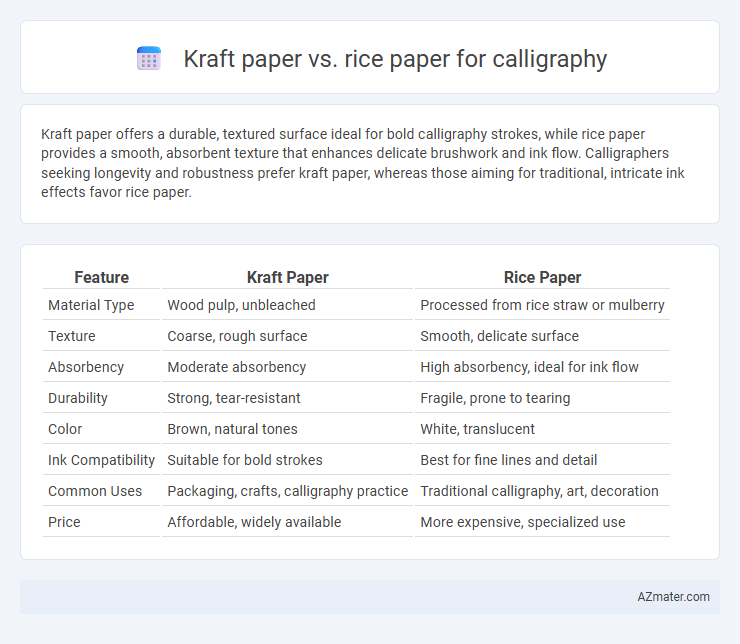Kraft paper offers a durable, textured surface ideal for bold calligraphy strokes, while rice paper provides a smooth, absorbent texture that enhances delicate brushwork and ink flow. Calligraphers seeking longevity and robustness prefer kraft paper, whereas those aiming for traditional, intricate ink effects favor rice paper.
Table of Comparison
| Feature | Kraft Paper | Rice Paper |
|---|---|---|
| Material Type | Wood pulp, unbleached | Processed from rice straw or mulberry |
| Texture | Coarse, rough surface | Smooth, delicate surface |
| Absorbency | Moderate absorbency | High absorbency, ideal for ink flow |
| Durability | Strong, tear-resistant | Fragile, prone to tearing |
| Color | Brown, natural tones | White, translucent |
| Ink Compatibility | Suitable for bold strokes | Best for fine lines and detail |
| Common Uses | Packaging, crafts, calligraphy practice | Traditional calligraphy, art, decoration |
| Price | Affordable, widely available | More expensive, specialized use |
Introduction to Calligraphy Paper Choices
Kraft paper offers a sturdy, textured surface ideal for bold calligraphy strokes and ink absorption, making it suitable for practice and rustic designs. Rice paper, prized for its delicate, smooth finish, allows for fine line precision and fluid brush movement, favored in traditional Asian calligraphy. Selecting between kraft and rice paper depends on the desired ink behavior, texture, and calligraphy style, with each paper type enhancing distinct artistic effects.
What is Kraft Paper?
Kraft paper is a durable, coarse-textured paper made from wood pulp using the kraft process, known for its strength and natural brown color. It offers excellent ink absorption and resistance to tearing, making it ideal for bold calligraphy strokes and projects requiring longevity. Compared to rice paper, kraft paper provides a more robust surface that handles heavier inks without bleeding or warping.
What is Rice Paper?
Rice paper, traditionally made from the fibers of the mulberry tree or bamboo, offers a smooth, absorbent surface ideal for calligraphy and brush painting. Unlike kraft paper, which is thicker and more textured, rice paper allows for precise ink flow and delicate brush strokes, enhancing the quality of traditional East Asian calligraphy. Its lightweight, semi-translucent nature contributes to its popularity among artists seeking authenticity and finesse in their work.
Texture and Surface Comparison
Kraft paper features a coarse, fibrous texture with a rough surface that absorbs ink unevenly, often causing bleeding and less precise strokes in calligraphy. Rice paper offers a smooth, delicate surface with a fine grain that allows for crisp, clean lines and better ink control, making it ideal for intricate brushwork. The porous nature of rice paper ensures optimal ink absorption without spreading, while kraft paper's uneven texture can hinder detailed calligraphy performance.
Ink Absorption and Bleeding
Kraft paper exhibits moderate ink absorption with a slightly rough texture that can cause some bleeding and feathering in calligraphy, especially with wet inks. Rice paper, known for its thin and highly absorbent structure, quickly soaks up ink, minimizing bleeding but requiring precise control to avoid excessive spreading. Choosing between the two depends on the desired ink flow and detail retention, with rice paper preferred for fine, delicate strokes and kraft paper favored for bold, rustic effects.
Durability and Longevity
Kraft paper offers superior durability and longevity for calligraphy due to its thick, fibrous texture that resists tearing and aging over time. Rice paper, while prized for its delicate appearance and absorbency, tends to be more fragile and susceptible to damage from moisture and handling. For artworks requiring lasting preservation and frequent handling, kraft paper is the more durable choice, maintaining ink integrity and structural stability.
Suitability for Different Calligraphy Styles
Kraft paper offers a textured surface that suits bold, expressive calligraphy styles like brush lettering and modern scripts due to its durability and resistance to ink bleed. Rice paper, known for its thin and delicate fibers, is ideal for traditional East Asian calligraphy and fine, detailed strokes, allowing smooth ink flow and subtle gradations. Choosing between kraft and rice paper depends on the desired calligraphy style, with kraft enhancing contemporary, robust designs and rice paper supporting intricate, classic brushwork.
Cost and Accessibility
Kraft paper offers a cost-effective and widely accessible option for calligraphy, making it ideal for practice and bulk projects due to its affordability and availability in most art supply stores. Rice paper, while more expensive and less commonly stocked, provides a traditional, delicate surface favored for high-quality calligraphy works and specialized brush techniques. The choice between kraft and rice paper largely depends on budget constraints and the desired aesthetic or texture for the calligraphy piece.
Environmental Considerations
Kraft paper, made from wood pulp, is biodegradable and often recycled, making it a relatively eco-friendly option for calligraphy projects. Rice paper, traditionally made from natural fibers like mulberry bark, is also biodegradable and compostable, but its production can be more sustainable due to fewer chemicals and less processing involved. Choosing rice paper supports eco-conscious calligraphy by minimizing environmental impact through renewable resources, whereas Kraft paper's large-scale production can entail higher carbon footprints despite its recyclability.
Which Paper is Best for Your Calligraphy Practice?
Kraft paper offers a smooth, durable surface ideal for practicing bold calligraphy strokes with brush pens and markers, while rice paper provides a delicate texture suited for traditional ink and brush work, emphasizing fluidity and fine detail. For beginners focusing on casual practice, kraft paper's resilience resists ink bleeding and tearing, making it more forgiving and cost-effective. Advanced calligraphers aiming to refine elegant, precise lettering may prefer rice paper for its authentic feel and ability to showcase nuanced brush techniques.

Infographic: Kraft paper vs Rice paper for Calligraphy
 azmater.com
azmater.com